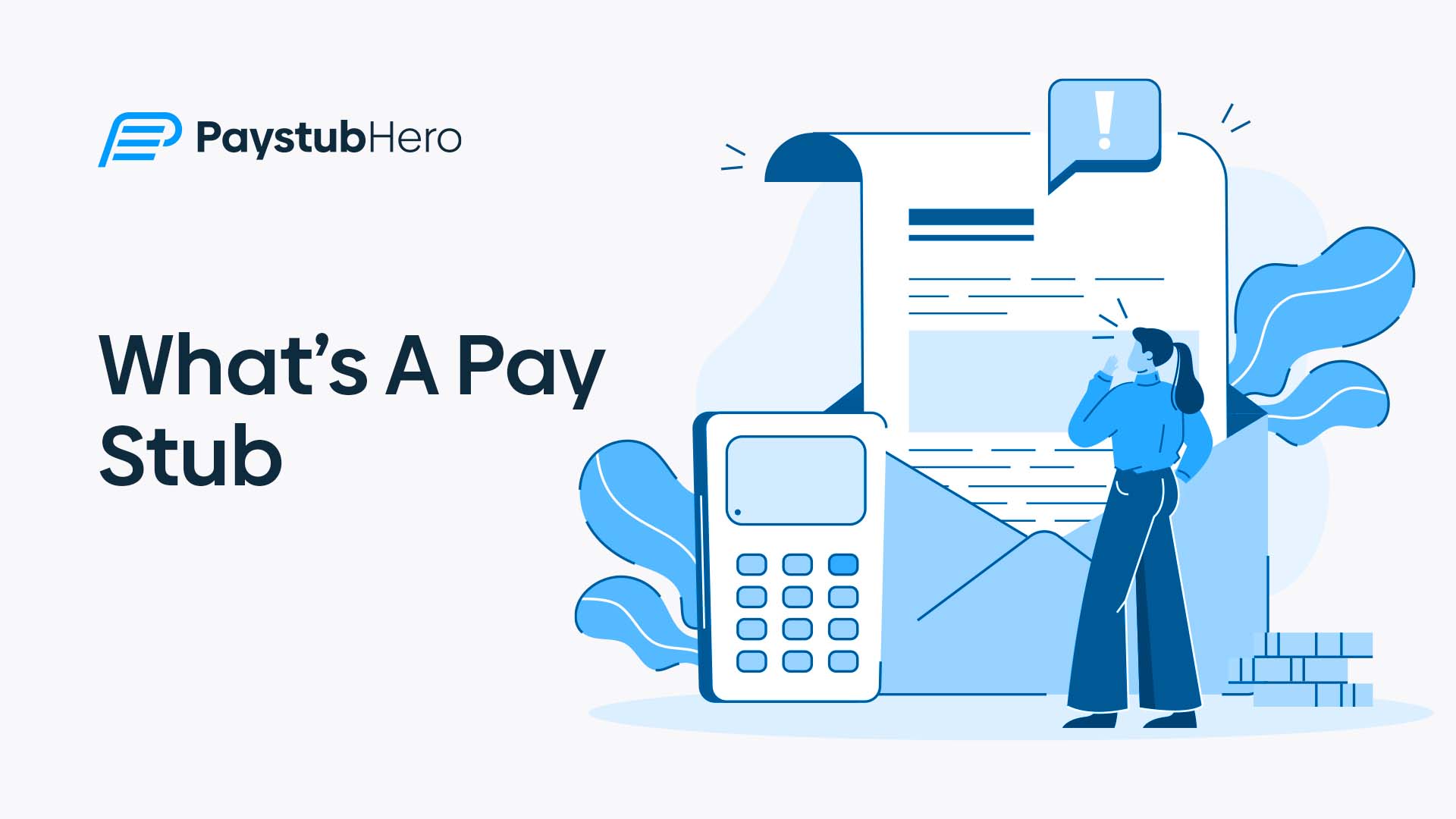Curious about your earnings and deductions? A pay stub holds the key to unlocking the details of your paycheck. So, what’s a pay stub exactly? Let’s break it down. In the vast expanse of financial terminology, there’s one term that everyone, from budding entrepreneurs to established professionals, comes across: a pay stub.
A pay stub, in its most straightforward definition, is a document that outlines the details of an employee’s pay. It serves as a proof of income, providing a breakdown of what an employee earns and what has been taken out, such as taxes and other deductions. The stub details earnings for a specific pay period – be it weekly, bi-weekly, or monthly – as well as the total earnings for the year.
But a pay stub is much more than just a piece of paper or a digital document with some numbers on it. It’s a key to financial transparency and an important tool for personal finance management.
With every line and every number, a pay stub offers insights into what you earn, where portions of your earnings are directed, and how much of your hard-earned money you actually get to take home.
Understanding a pay stub helps you stay on top of your finances, plan ahead, and ensures that you’re being paid what you’re owed. Despite its importance, however, the humble pay stub often remains unexplored and misunderstood.
That’s about to change. In this article, we dive into the world of pay stubs – exploring what they look like, how they’re generated, what they mean, and why they’re important.
By the end, you’ll be well-equipped to understand your own pay stub and make informed financial decisions based on its contents. So, let’s unravel the mystery of pay stubs together.
Table of Contents:
- Introduction: What’s a Pay Stub?
- Exploring the Anatomy of a Pay Stub: A Detailed Breakdown
- The Magic Behind Pay Stub Generators: Simplifying Payroll One Stub at a Time
- Unearthing the Paystub Meaning: More Than Just a Piece of Paper
- Making Sense of Pay Stub Statistics: Understanding Your Finances One Number at a Time
- Putting it All Together: The Crucial Role of Pay Stubs in Your Financial Journey
Exploring the Anatomy of a Pay Stub: A Detailed Breakdown
Many of us are left scratching our heads when confronted with the question, “What’s a pay stub look like?” To the untrained eye, a pay stub might seem like an overwhelming array of numbers and categories. However, breaking it down into its individual components can provide a clearer understanding.
Imagine a comprehensive financial report card, a document that offers a window into your income, one pay period at a time. That’s what a pay stub essentially is. Every pay stub, irrespective of the layout, typically features certain key elements.
Gross wages, which constitute your total earnings before any deductions, make up the first part of your pay stub. Then come the various deductions, such as federal and state taxes, health insurance premiums, social security contributions, and perhaps even retirement contributions like 401(k).
The complexity of these deductions often underscores the importance of a pay stub in tracking where your earnings are going.
Your pay stub will also include the net pay, or ‘take-home’ pay, which is the amount left after all the deductions are made from your gross wages.
Another key aspect featured in your pay stub is the year-to-date (YTD) totals for all these categories. This means it not only provides information for the specific pay period but also shows cumulative figures for the entire year to date. This makes a pay stub an invaluable tool for managing personal finances and preparing for tax season.
Understanding the anatomy of a pay stub means appreciating the depth of information it contains. From providing a snapshot of your current financial situation to helping track your income over time, a pay stub does it all, making it one of the most underrated yet vital documents in your financial repertoire.
The Magic Behind Pay Stub Generators: Simplifying Payroll One Stub at a Time
The days of manually crafting handwritten pay stubs have faded into the annals of business history. Now, the spotlight is firmly on digital solutions, like pay stub generators, that have revolutionized the way businesses handle payroll.
But what exactly goes into these modern marvels of financial technology? Let’s pull back the curtain and find out.
A pay stub generator, in essence, is an automated platform designed to create accurate and compliant pay stubs.
By entering key details like the employee’s pay rate, hours worked, and deductions, these generators can instantly produce a comprehensive pay stub. The entire process is seamless, and the reduction in manual labor helps minimize errors that can occur in manual calculations.
What makes these platforms so magical isn’t just the accuracy they offer, but also their incredible efficiency. Imagine the countless hours saved when a business switches from crafting pay stubs by hand to letting an automated system do the work. This time can be better spent focusing on other critical areas of business operations.
Beyond just time and accuracy, a pay stub generator offers enhanced accessibility. It’s all online, which means pay stubs can be created, accessed, and stored from anywhere, making payroll management significantly more convenient.
Lastly, pay stub generators ensure compliance with state and federal laws. Each state has different requirements for what must be included in a pay stub, and keeping track of these can be daunting.
Pay stub generators simplify this process by staying up-to-date with the latest legislation, providing peace of mind to businesses.
In summary, pay stub generators take a complex, time-consuming process and streamline it into an efficient and accurate system. They are a testament to how technology is simplifying the world of finance, one pay stub at a time.
Unearthing the Paystub Meaning: More Than Just a Piece of Paper
Pay stub, payslip, paycheck stub – these terms are often used interchangeably, but what exactly do they signify? “Paystub” might seem like a piece of financial jargon, but its meaning is not only straightforward but also crucial to understand for anyone earning a paycheck.
At its core, a pay stub is a document given to an employee as a record of their earned income. But the paystub meaning extends far beyond that simple definition. This humble document serves multiple purposes, each of significant importance in the realm of personal finance and employment.
First and foremost, a pay stub serves as a legal record of an employee’s salary or wages. It provides a detailed account of the employee’s gross income, deductions, and net income, making it a trusted document in matters of finance and law.
This record-keeping function is essential not only for employees but also for employers to maintain transparency and accuracy in financial dealings.
Moreover, a pay stub is an essential tool for personal financial management. By providing a breakdown of where your income is going, from taxes to health insurance deductions, a pay stub can help you understand your financial health better and plan accordingly. It’s a roadmap guiding you through your earnings and spending, enabling you to make informed financial decisions.
But the value of a pay stub isn’t limited to just the bearer. These documents also serve crucial roles in the broader financial landscape. They are often required for verifying employment or income, such as when applying for a loan, renting an apartment, or even for certain immigration processes.
In essence, a pay stub is far more than just a record of your earnings. It’s a critical document in the world of finance, with implications reaching far beyond payday. From personal financial planning to navigating the complexities of loans and rentals, the importance of understanding your pay stub cannot be overstated.
Making Sense of Pay Stub Statistics: Understanding Your Finances One Number at a Time
Despite being a staple document in the world of employment and finance, pay stubs are often overlooked. But a closer look at some pay stub statistics can shed light on why understanding them is so essential.
Firstly, it’s important to recognize the role pay stubs play in improving financial literacy. According to the National Financial Educators Council, 41.4% of adults in the U.S gave themselves a grade of C, D, or F on their knowledge of personal finance. This statistic is a stark reminder of the gap in understanding that exists when it comes to managing personal finances. Pay stubs can help bridge this gap.
By providing a clear, itemized breakdown of earnings and deductions, pay stubs demystify the complexities of personal income and offer individuals a tangible way to improve their financial knowledge.
In the context of employment, pay stubs can be equally illuminating. They help ensure fair and transparent wage practices. For instance, the U.S. Bureau of Labor Statistics reported that there were around 73.3 million hourly-paid workers in 2020.
With such a substantial portion of the workforce receiving hourly wages, understanding pay stubs becomes critical to ensure these individuals are compensated correctly.
The power of pay stubs also extends to their role in facilitating financial transactions. For example, the Consumer Financial Protection Bureau notes that proof of income (which can be verified with a pay stub) is a common requirement for many kinds of loans.
Therefore, understanding your pay stub is key not only to managing your own finances but also to successfully navigating various financial processes.
In essence, making sense of pay stub statistics means recognizing the vital role these documents play in improving financial literacy, ensuring fair employment practices, and facilitating financial transactions.
It’s all about understanding the story that these numbers tell about your income and using that knowledge to make informed financial decisions.
Putting it All Together: The Crucial Role of Pay Stubs in Your Financial Journey
Understanding “what’s a pay stub” is not just about deciphering its definition. It’s a holistic process that involves recognizing its various components, its significance in personal financial management, and its role in the broader financial ecosystem.
When you get a pay stub, you’re not just receiving a receipt for your work, but a key to your financial well-being. It’s a comprehensive snapshot of your earnings, deductions, and net income. This granular level of detail can be instrumental in budgeting, managing personal finances, and even in tax planning.
But pay stubs are more than just personal financial tools. They also serve a legal purpose, acting as a record of your income. This can be crucial in various scenarios, from applying for a loan to seeking a rental property. Your pay stub, thus, is often your proof of financial stability and reliability.
Furthermore, with the advent of digital solutions like pay stub generators, understanding and managing pay stubs have become easier than ever. These tools offer a simplified and efficient way to create, store, and access pay stubs, making payroll management a breeze.
The key takeaway here is that pay stubs, while seemingly mundane, play a crucial role in the financial lives of both individuals and businesses.
By understanding the ins and outs of pay stubs, you equip yourself with the knowledge to navigate your financial journey with greater confidence and foresight.
In conclusion, a pay stub is not just a piece of paper or a digital document but a multi-purpose tool, with roles spanning from being a personal financial planner to a legal document.
In the world of finance, knowledge is power, and understanding your pay stub equates to empowering yourself for a healthy financial future.
Frequent Asked Questions
- How do I get my pay stubs?
- Pay stubs are typically provided by your employer with each paycheck. For digital pay stubs, check your email or your employer’s online payroll portal.
- Is a pay stub your paycheck?
- No, a pay stub is not the paycheck itself. It’s a document provided with your paycheck that details your earnings, deductions, and net pay.
- What is the meaning of a pay stub?
- A pay stub is a document provided by your employer that records your earned income, tax deductions, and net income for a specific pay period.
- What is a pay stub look like?
- A pay stub typically displays your gross income, various deductions (like taxes and insurance premiums), and net income. It also often shows year-to-date totals for these categories.








